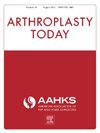A Single Surgeon Experience of Selective Patellar Resurfacing During Primary Total Knee Arthroplasty
IF 2.1
Q3 ORTHOPEDICS
引用次数: 0
Abstract
Background
Routine patellar resurfacing remains controversial in primary total knee arthroplasty (TKA). This study reports the experience of a high-volume arthroplasty surgeon who stopped routinely resurfacing patellae for a 3-year period.
Methods
All primary TKAs performed by a single surgeon between January 2018 and September 2022 with minimum 1-year follow-up were retrospectively reviewed. Data were analyzed between cohorts—nonresurfaced and resurfaced patellae—and between phases—universal and selective resurfacing. Outcomes included reoperation, patellar complications, and patient-related outcome measure scores.
Results
Five hundred four primary TKAs, with mean 24-month follow-up, were included. Patellar resurfacing was performed in 77% of the overall cohort, including 58% in the selective and 100% in the universal phases. Reoperation (7.6% vs 0.3%; P < .001) and patellar complications (8.4% vs 1.3%; P < .001) were higher in the nonresurfaced vs resurfaced cohort. Eight of the 9 reoperations in the nonresurfaced group were for secondary resurfacing, and all were female (P = .017). Mean 12-Item Short Form Health Survey Physical Health (P = .037) and Western Ontario and McMaster Universities Arthritis Index Pain scores (P = .002) were better in the resurfaced cohort. Selective resurfacing demonstrated a higher reoperation rate (3.3% vs 0.4%; P = .022) and worse Western Ontario and McMaster Universities Arthritis Index Pain (P = .026) and Knee Society Knee Functional scores (P = .042).
Conclusions
Cessation of routine patellar resurfacing led to inferior clinical results and an unacceptably high early reoperation rate, specifically among women. The generalizability of these findings may be limited due to surgeon-specific factors; however, we urge caution in surgeons who consider similar changes in practice.
Level of Evidence
Level III.
单个外科医生在初级全膝关节置换术中选择性髌骨复位的经验
背景在初级全膝关节置换术(TKA)中,常规髌骨再植仍存在争议。本研究报告了一位高产量关节置换术外科医生在 3 年内停止常规髌骨重铺的经验。方法回顾性审查了 2018 年 1 月至 2022 年 9 月期间由一位外科医生实施的所有初级 TKA,随访至少 1 年。对不同队列--未再表面化和再表面化髌骨--以及不同阶段--普遍再表面化和选择性再表面化之间的数据进行了分析。结果包括再手术、髌骨并发症和患者相关结果测量评分。77%的患者进行了髌骨重置,其中58%的患者进行了选择性髌骨重置,100%的患者进行了普遍性髌骨重置。再手术率(7.6% vs 0.3%; P <.001)和髌骨并发症(8.4% vs 1.3%; P <.001)在非髌骨表面移植组和髌骨表面移植组中都较高。非磨面组的 9 例再手术中有 8 例是二次磨面,且均为女性(P = .017)。再植骨面组的平均 12 项简表健康调查身体健康评分(P = .037)和西安大略与麦克马斯特大学关节炎指数疼痛评分(P = .002)均优于再植骨面组。结论 常规髌骨再植术的停止导致了较差的临床效果和不可接受的高早期再手术率,尤其是在女性患者中。由于外科医生的特异性因素,这些研究结果的推广性可能有限;但是,我们建议外科医生在考虑改变类似做法时要谨慎。
本文章由计算机程序翻译,如有差异,请以英文原文为准。
求助全文
约1分钟内获得全文
求助全文
来源期刊

Arthroplasty Today
Medicine-Surgery
CiteScore
2.90
自引率
0.00%
发文量
258
审稿时长
40 weeks
期刊介绍:
Arthroplasty Today is a companion journal to the Journal of Arthroplasty. The journal Arthroplasty Today brings together the clinical and scientific foundations for joint replacement of the hip and knee in an open-access, online format. Arthroplasty Today solicits manuscripts of the highest quality from all areas of scientific endeavor that relate to joint replacement or the treatment of its complications, including those dealing with patient outcomes, economic and policy issues, prosthetic design, biomechanics, biomaterials, and biologic response to arthroplasty. The journal focuses on case reports. It is the purpose of Arthroplasty Today to present material to practicing orthopaedic surgeons that will keep them abreast of developments in the field, prove useful in the care of patients, and aid in understanding the scientific foundation of this subspecialty area of joint replacement. The international members of the Editorial Board provide a worldwide perspective for the journal''s area of interest. Their participation ensures that each issue of Arthroplasty Today provides the reader with timely, peer-reviewed articles of the highest quality.
 求助内容:
求助内容: 应助结果提醒方式:
应助结果提醒方式:


